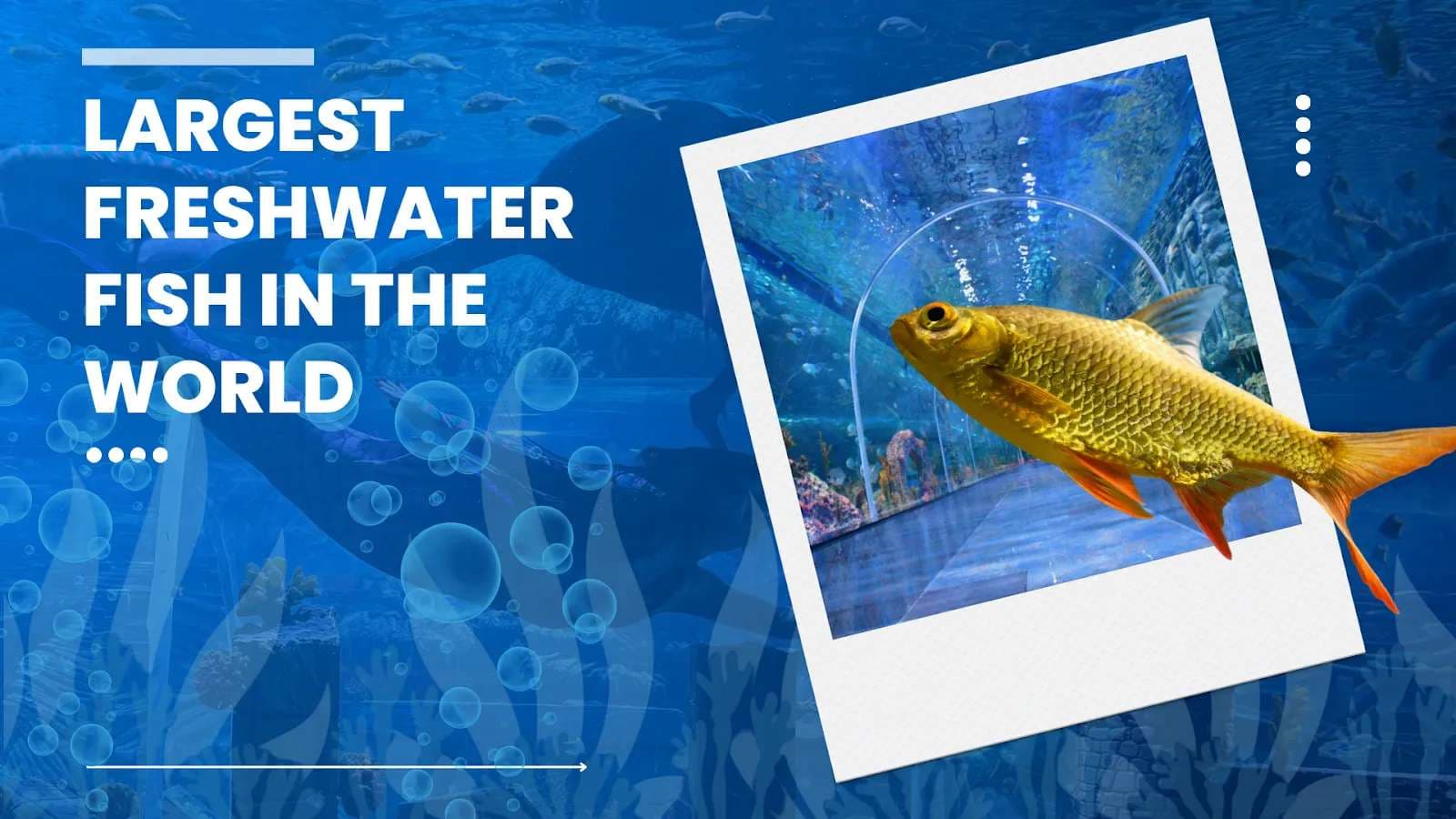
Largest Freshwater Fish in the World in 2025
Discover the largest freshwater fish, like the huge Giant Freshwater Stingray and Mekong Giant Catfish. Click to explore these massive species!
Rivers worldwide hide remarkable giants beneath their murky surfaces. The planet's largest freshwater fish species showcase nature's incredible diversity and power. These aquatic titans have survived for millions of years, adapting to environments ranging from tropical deltas to arctic streams.
However, while they still exist, they’re harder to find than ever. In this article, we list the largest freshwater fish ever recorded and share key facts about where they live, how they grow, and what threatens their future.
It’s a chance to understand these giants beyond just their size and see what their presence means for our rivers.
12 Largest Freshwater Fishes in the World With Detailed Descriptions
Freshwater environments support remarkable fish species that can reach massive proportions. These impressive dimensions are measured through different metrics, including total length, maximum recorded weight, and overall biomass.
The following twelve species showcase the largest freshwater fish found across rivers, lakes, and freshwater habitats on six continents.
1. Beluga Sturgeon (Huso huso)
The beluga sturgeon reigns as the undisputed champion of freshwater giants. These ancient fish can live over 100 years and grow to extraordinary proportions in the Caspian Sea basin.
This huge fish produces the world's finest caviar, making them incredibly valuable yet critically endangered. Their prehistoric appearance and massive size make them living dinosaurs of the aquatic world.
- Maximum Size: Up to 7 metres long and 1,500 kg in weight.
- Habitat: Caspian and Black Sea basins, migrating to rivers for spawning.
- Lifespan: Can exceed 100 years in the wild.
- Diet: Fish, crustaceans, and molluscs as adults.
- Conservation Status: Critically endangered due to overfishing and dam construction.
2. White Sturgeon (Acipenser transmontanus)
North America's largest freshwater fish, the white sturgeon, dominates Pacific coast river systems. These bottom-dwelling giants can reach incredible sizes, with some specimens recorded over 6 metres long.
White sturgeons are anadromous, meaning they migrate between saltwater and freshwater environments. Their cartilaginous skeleton and lack of scales make them unique among large freshwater species.
- Maximum Size: Up to 6 metres long and 800 kg in weight.
- Habitat: Pacific coast rivers from Alaska to California.
- Lifespan: Can live over 80 years.
- Diet: Bottom-dwelling invertebrates, fish, and crustaceans.
- Conservation Status: Vulnerable with strictly regulated fishing.
3. Arapaima (Arapaima gigas)
The arapaima stands as South America's freshwater giant, perfectly adapted to oxygen-poor waters. These air-breathing fish surface regularly to gulp oxygen, allowing them to survive in Amazon tributaries where other large fish cannot.
Their massive scales act like armour, protecting them from piranha attacks. Fun fact: research suggests that scales possess the right amount of toughness to qualify as a bulletproof vest.
- Maximum Size: Up to 4.5 metres long and 200 kg in weight.
- Habitat: Amazon and Orinoco river basins.
- Lifespan: Approximately 15-20 years in the wild.
- Diet: Fish, birds, small mammals, and insects.
- Conservation Status: Vulnerable due to overfishing and habitat loss.
4. Wels Catfish (Silurus glanis)
Europe's largest freshwater predator, the wels catfish, has expanded its range dramatically in recent decades. These nocturnal hunters use their sensitive barbels to detect prey in murky waters.
Wels catfish are opportunistic feeders known to consume surprisingly large prey, including waterfowl and small mammals. Their ability to adapt to various water conditions has made them successful invasive species in many regions.
- Maximum Size: Up to 4 metres long and 300 kg in weight.
- Habitat: European rivers and lakes, spreading to new territories.
- Lifespan: Can live over 60 years.
- Diet: Fish, frogs, birds, and small mammals.
- Conservation Status: Least concern, considered invasive in some areas.
5. Mekong Giant Catfish (Pangasianodon gigas)
The Mekong giant catfish represents one of the world's largest purely freshwater fish species. These gentle giants filter-feed on algae and plant matter, growing to enormous sizes in the nutrient-rich Mekong River.
Unfortunately, dam construction and overfishing have pushed this species to the brink of extinction. Their smooth, scaleless skin and distinctive appearance make them easily recognisable.
- Maximum Size: Up to 3 metres long and 300 kg in weight.
- Habitat: Mekong River basin in Southeast Asia.
- Lifespan: Estimated 30-60 years.
- Diet: Algae, plant matter, and small organisms.
- Conservation Status: Critically endangered with fewer than 1,000 individuals remaining.
6. Giant Freshwater Stingray (Urogymnus polylepis)
The giant freshwater stingray holds the record as the world's largest freshwater fish by weight. These flattened giants inhabit muddy river bottoms across Southeast Asia, using their electroreceptive abilities to hunt buried prey.
Their venomous tail barb can inflict serious injuries, making them formidable despite their generally peaceful nature. Recent research suggests they may be even larger than previously documented.
- Maximum Size: Up to 5 metres across and 600 kg in weight.
- Habitat: Mekong River system and Southeast Asian rivers.
- Lifespan: Unknown, possibly several decades.
- Diet: Small fish, invertebrates, and worms.
- Conservation Status: Endangered due to habitat destruction and fishing pressure.
7. Alligator Gar (Atractosteus spatula)
The alligator gar combines prehistoric appearance with modern predatory efficiency. These living fossils have remained virtually unchanged for millions of years, sporting diamond-shaped scales and elongated jaws filled with sharp teeth.
Alligator gars can breathe air, allowing them to survive in low-oxygen environments where other large fish struggle. Their ambush hunting style makes them apex predators in their aquatic ecosystems.
- Maximum Size: Up to 3 metres long and 140 kg in weight.
- Habitat: Mississippi River basin and Gulf Coast drainages.
- Lifespan: Can exceed 50 years.
- Diet: Fish, birds, small mammals, and reptiles.
- Conservation Status: Stable but protected in many states.
8. Taimen (Hucho taimen)
The taimen represents the largest member of the salmon family, earning the nickname "river wolf" for its aggressive hunting behaviour. These cold-water predators inhabit pristine rivers across Mongolia, Siberia, and parts of China.
Taimen are incredibly territorial and can live for decades in the same river section. Their copper-coloured scales and massive size make them prized by sport fishermen worldwide.
- Maximum Size: Up to 2 metres long and 100 kg in weight.
- Habitat: Cold rivers in Mongolia, Siberia, and northern China.
- Lifespan: Can live over 30 years.
- Diet: Fish, small mammals, and waterfowl.
- Conservation Status: Vulnerable due to habitat degradation and overfishing.
9. Murray Cod (Maccullochella peelii)
Australia's largest freshwater fish, the Murray cod, rules the continent's river systems with its powerful build and aggressive nature. These speckled giants are highly territorial and can live for many decades in the same river pool.
Murray cod are ambush predators that strike with lightning speed, using their large mouths to engulf prey. Their cultural significance to Indigenous Australians adds to their conservation importance.
- Maximum Size: Up to 2 metres long and 100 kg in weight.
- Habitat: Murray-Darling river system in southeastern Australia.
- Lifespan: Can exceed 40 years.
- Diet: Fish, yabbies, frogs, and aquatic insects.
- Conservation Status: Vulnerable due to river regulation and habitat loss.
10. Paddlefish (Polyodon spathula)
The paddlefish represents one of North America's most unusual freshwater giants, using its distinctive paddle-shaped rostrum to filter-feed like a whale. These ancient fish have survived since the time of dinosaurs, filtering zooplankton from muddy river waters.
Paddlefish are highly migratory, travelling hundreds of kilometres during their spawning runs. Their prehistoric appearance and unique feeding method make them truly remarkable creatures.
- Maximum Size: Up to 2.2 metres long and 90 kg in weight.
- Habitat: Mississippi River basin and tributaries.
- Lifespan: Can live over 30 years.
- Diet: Zooplankton, small fish, and aquatic insects.
- Conservation Status: Vulnerable with declining populations.
11. Nile Perch (Lates niloticus)
The Nile perch stands as Africa's largest freshwater predator, dominating the continent's major river systems and lakes. These silvery giants are voracious hunters that can dramatically alter aquatic ecosystems where they're introduced.
Nile perch is an important commercial fish species, but it has caused ecological problems in some areas. Their rapid growth and aggressive nature make them formidable apex predators.
- Maximum Size: Up to 2 metres long and 200 kg in weight.
- Habitat: Nile River system and East African lakes.
- Lifespan: Can live over 20 years.
- Diet: Fish, crustaceans, and aquatic insects.
- Conservation Status: Least concern but considered invasive in some regions.
12. Golden Mahseer (Tor putitora)
One of India’s largest freshwater fish, the golden mahseer, commands respect in Himalayan river systems with its powerful build and golden scales. These magnificent fish are considered sacred in many Indian cultures and play critical roles in maintaining the river ecosystem balance.
Golden mahseers are incredibly strong fighters, making them legendary among sport fishing enthusiasts. Their preference for fast-flowing, oxygen-rich waters makes them indicators of healthy river systems.
- Maximum Size: Up to 2.7 metres long and 90 kg in weight.
- Habitat: Himalayan rivers and tributaries across India, Nepal, and Bhutan.
- Lifespan: Can live over 20 years in pristine conditions.
- Diet: Insects, crustaceans, smaller fish, and aquatic vegetation.
- Conservation Status: Endangered due to dam construction and river pollution.
Witness the Largest Collection of Freshwater Fish at Aquarium Paradise
Based in Bangalore, this ocean-themed adventure park is home to some of the most stunning aquatic species ever seen up close.
You can walk through massive glass tunnels and lose yourself in 180° panoramic views where freshwater giants glide right above your head.
It’s quiet, immersive, and almost surreal. The semi-circular tunnel design surrounds you with life from floor to ceiling, turning every step into a slow-motion moment you won’t forget.
Over 44+ Freshwater Fish Species
Aquarium Paradise houses one of India’s most diverse freshwater exhibits. From heavy-bodied river giants to vividly coloured cichlids, you’ll find species from South America, Southeast Asia, and the Indian subcontinent - all in one place.
Spot freshwater favourites like:
- Alligator Gar: A prehistoric predator with a snout full of sharp teeth and scales tough as armour.
- Silver Arowana: Known for its metallic sheen and ability to jump out of the water while feeding.
- Redtail Catfish: A South American heavyweight with a striking orange tail and bottom-feeding habits.
- Giant Gourami: Gentle, slow-moving, and one of the largest labyrinth fish in the world.
- Oscar Fish: Intelligent and bold, with a reputation for recognising regular visitors during feeding hours.
21+ Saltwater Wonders
While the freshwater tunnel brings calm, the saltwater gallery bursts with colour and movement. Species here tend to be smaller but far more vibrant. The textures, patterns, and formations you’ll see in these tanks rival any coral reef documentary.
Watch these saltwater stars up close:
- Clownfish: Bright orange with white stripes, often seen darting through sea anemones.
- Moon Wrasse: Blue-green shimmer with neon lines across its face, always in motion.
- Emperor Angelfish: Royal stripes and bold colour blocks that stand out in any tank.
- Pufferfish: Round, slow, and expressive, famous for puffing up when stressed.
- Moray Eel: Peeks out from rocky crevices with a sideways stare and sudden lunges that leave kids wide-eyed.
Exotic Shark Species
Aquarium Paradise also features two remarkable shark species that bring a quiet intensity to the experience. Unlike the fast swirl of reef fish or the slow drift of river giants, these sharks move with steady purpose. You won’t find them circling wildly—they cruise, observe, and hold your attention without trying.
- Blacktip Shark (Carcharhinus limbatus): Easily recognised by the black markings on its fins, this species is sleek and swift. Found in tropical coastal waters, it moves in smooth, confident bursts. Its streamlined body and sharp turns offer a glimpse into how precision looks in motion.
- Lemon Shark (Negaprion brevirostris): Pale yellow-brown in colour, the lemon shark blends into sandy seabeds with ease. It’s heavier, more grounded, and often moves in small groups. There’s a sense of calm in how it glides - slow, deliberate, and always aware of its surroundings.
These exhibits are thoughtfully designed to reflect each shark’s natural environment. If you watch closely, you’ll notice the way they interact with light, space, and each other.
Other Reasons to Visit Aquarium Paradise
Apart from the impressive fish collection, several unique attractions make this destination special. The facility combines education with entertainment through interactive experiences and stunning visual displays.
Each attraction offers different perspectives on marine life and aquatic environments. These additional features transform a simple aquarium visit into a comprehensive underwater adventure.
- Mermaid Show: Professional swimmers perform graceful underwater routines in giant tanks. Held multiple times a day, and included with your ticket.
- Jellyfish Room: Translucent creatures pulse under soft lighting in a reflective chamber, creating an otherworldly atmosphere.
- Artificial Waterfalls: Cascading water features throughout the facility create peaceful photo spots and a fresh rainforest ambience.
- Ocean Window Lounge: Comfortable seating area with marine-themed décor provides a relaxation space between exhibits.
- Interactive Fish Feeding Sessions: Visitors learn about aquatic diets and conservation from knowledgeable staff members.
- Shark Viewing Zone: A quiet, dimly lit space where visitors can observe blacktip and lemon sharks swimming in custom-designed tanks.
Conclusion
Freshwater giants represent some of nature's most remarkable evolutionary achievements, spanning continents and centuries of adaptation.
These magnificent creatures remind us that our planet's rivers and lakes hold treasures as impressive as any ocean-dwelling species. From prehistoric sturgeons to modern conservation success stories, each species tells a unique tale of survival.
Aquarium Paradise offers a rare opportunity to observe these aquatic marvels in carefully maintained environments designed with utmost care for their well-being.
Walking through the panoramic tunnels, visitors can appreciate the grace and power of species that would otherwise remain hidden beneath distant waters. Our facility's commitment to education and conservation makes each visit both entertaining and meaningful.
If you're planning a visit, it's best to book your tickets online. That way, you’ll get the timing you prefer and avoid waiting at the counter.
More To Read

6.17.2025
Top 10 Largest Crab Species Worldwide
Compare the largest crab in the world like the Japanese Spider and Coconut Crab. Explore traits, habitats, and conservation efforts. Click to know more!

9.4.2025
10 Fun Places in Bangalore Where Kids Can Play, Learn & Explore
Find the best kids fun places near you in Bangalore! Explore activities that blend play, learning, and family time for a perfect day out.

5.22.2025
Explore the Mesmerizing Aqua Tunnel in Bengaluru
Discover Bengaluru's Aqua Tunnel, a top tourist spot with stunning aquatic displays and interactive experiences. Plan your visit today!

5.16.2025
Mesmerising Little Mermaid Shows Near You
Discover the magic of Aquarium Paradise in Bangalore with its unique underwater tunnel, mermaid show, and interactive marine experiences. Get more info here.
